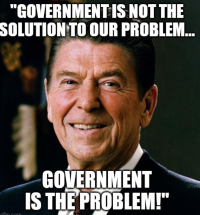
“Government is not the solution to our problem, government is the problem.”
When the then-former governor Ronald Reagan casually dropped this well-versed line on Johnny Carson, it set the stage for 50 years of growing vilification of public service. Now, this legacy culminates in everyone’s favorite immigrant indiscriminately firing half the federal government as millions cheer him on.
What if this immigrant’s scorched-earth search for government waste everyone knows is there is the exact worst thing to do right now? What if, instead of firing the nameless, faceless bureaucrats we’ve come to resent so, we instead asked them to do even less for their paychecks?
Don’t look now, but plenty of very smart, very anxious people believe that outcome is a very real possibility—not just in government, but across every industry. This is why the present administration’s gutting of government agencies is the exact wrong move at this moment. And those doing it, know it.
Three million people work for the federal government. Half of them annually spend some 1,800 hours processing paperwork to ensure everyone is paying their fair share, getting their fair share and/or playing by rules so many of us resent. These are jobs that can be, and are being, computerized.
The other half of government workers provide vital functions: curing diseases, delivering our mail, forecasting the weather, and ensuring our planes don’t crash. These are the government services we value so much that the private sector is eager to take them over—with dollar signs in their eyes.
That’s three million tax-payer-paid salaries and their budgets we could theoretically chop off our tax bills while opening vast investment opportunities to grow the private sector.
This capitalist dream-come-true explains why so many still cheer on the brutal realities befalling the very people working on their behalf. This enthusiasm is also fueled by the perception—rightly or wrongly—that government jobs are cushy, with benefit packages private-sector workers can only envy.
These are the highway workers leaning on their shovels in the closed-down lane, making you late for dinner. They’re the surly women at records counters demanding forms be filled out properly. They’re the irascible State Department functionaries, taking out their anger over being stationed in Pakistan, on your Middle East software reseller’s Visa application.
Government employees sit at the awkward nexus of anonymously keeping the world turning while all too often getting in its way. So why not fire a few million of them?
Because those government employees grinding away at jobs soon to be computerized or privatized are about to be joined by several millions more private-sector workers whose assignments computers can do better, faster, and far more affordably.
Perhaps that’s what I find most sinister about this administration. Everybody’s favorite immigrant—and a select handful of friends and politicians—knows all too well the chaos about to unfold as automation and artificial intelligence render at least half of all human endeavor obsolete, both public and private.
They also know the incalculably vast proceeds from this automation dividend could easily meet the basic needs of all these nouveaux pauvres—with plenty left over for their yachts and G5s. Or, they could hoard it all and rule the world.
This is why everyone’s favorite immigrant is tearing down, as fast as possible, the very institutions best suited to absorb the shock of this looming economic earthquake: government agencies.
With rigid salary structures and health benefit programs already in place, these agencies represent an equitable distribution of wealth in exchange for–let’s be honest–increasingly unnecessary services. Call it welfare if you want, but it’s welfare with a built-in work requirement. Jobs that one can still lose.
Instead, everyone’s favorite immigrant is laying the groundwork to ensure the pending productivity dividend goes into as few hands as possible, with no plan for those whose efforts—past and present—made this windfall possible. Too conspiratorial? You might also call it capitalist.
Either way, there is the potential for theft on a scale making Putin’s privatization of the USSR’s government assets look like shoplifting penny candy. And to think, it’s thanks in large part to the general disdain and envy for those working in government that another government employee planted in the public’s mind 50 years ago. All to look glib before seeking the chair his predecessor now considers a throne.